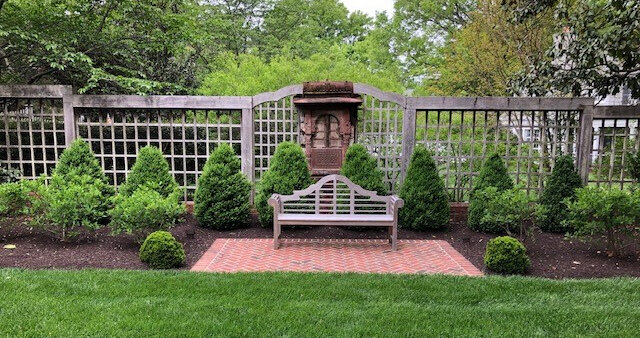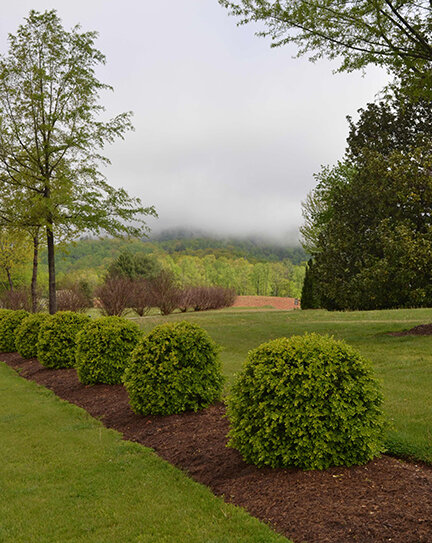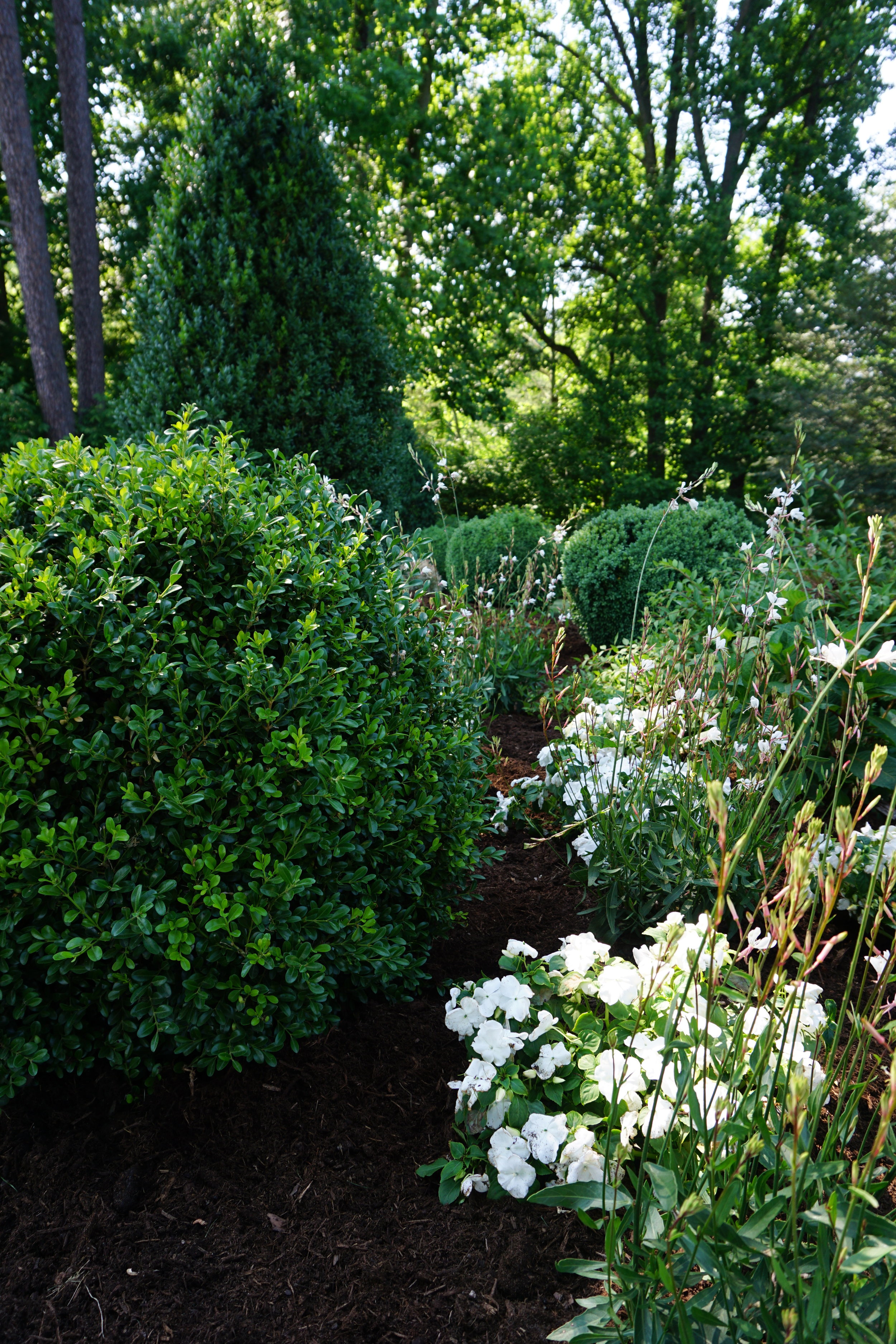By Holly Scoggins and J. Bennett Saunders
The cooler, wetter months of autumn are an ideal time for planting woody ornamentals and herbaceous perennials, especially boxwood (Buxus species and cultivars). Let’s review some cultivar selection tips and best practices for design, planting, and aftercare.
Boxwood, historically the aristocrat of shrubs, remains a popular choice for more formal landscapes. Though substitutes are touted, nothing tops the lush evergreen foliage, shape-ability, and that irreplaceable quality of deer-resistance of boxwood.
The quiet sophistication of boxwood in a formal garden is unmatched, and best management practices will help keep them healthy and beautiful. (photo courtesy of Tom Belden, John Richmond Landscaping, Inc.)
Boxwood do have a few important pests and pathogens. Regarding pests, boxwood leafminer (Monarthropalpus flavus) is an issue across much of the United States. Box tree moth (Cydalima perspectalis) has made its way to North America. Boxwood blight Calonectria pseudonaviculata is taking its toll on boxwood in eastern North America as well the West Coast. The fungal disease thrives with mild temperatures (60°-77°F) and wet conditions and can survive for years in infected plant debris. However, there are several keys to optimizing boxwood health in the landscape and reducing the chance of boxwood diseases and pests —cultivar selection, attentiveness to mature size/spacing and site selection.
Which Boxwood?
Success starts with plant selection. No boxwood variety can claim complete resistance to both boxwood blight and boxwood leafminer, but research trials and field experience with more than 130 varieties reveal some common-sense selections. To cross off the list: Buxus sempervirens ‘Suffruticosa’ (European or English Boxwood) - a “plant of the past” that is highly susceptible to boxwood blight - many good alternatives exist. Buxus sempervirens (American Boxwood) cultivars vary in their landscape performance and degree of blight and leafminer resistance. However, Buxus microphylla varieties topped resistance rating and are thus a good choice for blight-prone areas that also experience leafminer. The cold-hardy Buxus sinica var. insularis hybrids such as ‘Green Velvet’ show some resistance to boxwood blight but susceptibility to boxwood leafminer. A terrific source of cultivar-specific information is the beloved “Boxwood Guide” published by Saunders Brothers Inc. and now in its 6th edition - PDF available for free - download at https://www.saundersbrothers.com/page/Boxwood-Guide
All cultivars listed below exhibit reasonable resistance to both boxwood blight and boxwood leafminer.
· Low hedges and other edging purposes call for dwarf cultivars, such as B. microphylla ‘Little Missy’ and B.sinica var. insularis ‘Nana’. Always confirm mature size of a cultivar.
· For classic green orbs as specimens or foundation plants in the 3-to-5-foot range, consider NewGen Freedom® (Buxus ‘SB 300’ PP324421) or NewGen Independence® (Buxus ‘SB 108’ PP28888), both of B. microphylla heritage. Buxus microphylla var. japonica ‘Green Beauty’ is also a durable choice but may require leafminer management. When a gold variegated form is desired, B. microphylla Golden Dream (‘Peergold’PP16052) shows reasonable resistance to both issues.
· Upright boxwood are irreplaceable for vertical interest. Though a bit more susceptible to blight in trials, B.sempervirens cultivars ‘Dee Runk’ and ‘Fastigiata’ remain popular. When used for vertical interest, proper spacing and placing them in a location with good airflow can help mitigate boxwood blight.
Boxwood plays well with others! Orbs of boxwood NewGen Independence® and a hedge of ‘Little Missy’ compliment the sparkling summer blooms of Oakleaf hydrangea (Hydrangea quercifolia ‘Munchkin’). (Photo courtesy of Paul Westervelt, Saunders Brothers Inc.)
Site Selection, Spacing, and Installation
When considering placement, note sun tolerance varies by cultivar. Afternoon shade is optimal. Another siting consideration—high and dry(ish) if possible. Boxwood appreciate well-drained soil and will struggle with wet feet. Good drainage minimizes the chance for Phytophthora and other root zone diseases.
As with any other landscape ornamentals, confirm cultivar-specific mature size when spacing to ensure long-term satisfaction with the project. What will the garden look like in 10 to 20 years?
For a border or other row-type application, clipped hedges are perpetually popular, but consider the “pearl necklace” approach as well—generous spacing allows for air movement, a key to reducing the potential for blight. If utilizing boxwood for a foundation planting, ensure sufficient spacing away from the structure and place well away from downspouts to maximize air circulation and minimize potential for a wet rootzone.
When installing, pay particular attention to best planting practices. Planting the top of the root ball approximately 2 inches above ground level, a bit higher than the soil line, helps ensure proper drainage.
Boxwood blight research has demonstrated that a light layer of mulch (one inch the first year, one-half inch per year thereafter) will reduce splashing of precipitation that might carry spores—boxwood blight spreads easily via mechanical/water movement. Overhead or other spray irrigation is discouraged for the same reason; drip irrigation is preferred. If hand-watering is required, direct your client to water the soil, not the foliage. Immediately after transplanting, water thoroughly again and continue to monitor moisture for 18 months or so, until the plant is established. Once severely drought-stressed, boxwood seldom recovers completely.
Here’s an example of proper selection and spacing for optimal air movement with Buxus microphylla var. japonica ‘Jim Stauffer’. The light layer of mulch prevents water splash and lessens potential for the spread of boxwood blight. (Photo courtesy of J. Bennett Saunders, Saunders Genetics, LLC).
Transplant Tips
If a client has a beloved (and healthy) specimen boxwood that requires relocation, fall is the best time for transplant efforts. Some landscapers have success transplanting during mild winters, particularly in USDA Plant Hardiness Zones 7-9. Proper timing will allow for maximum root growth when moisture is typically more abundant. This in turn better prepares the plant for dry summers.
Increase chances of success by adequately watering the plant prior to any digging. The root ball should be dug as wide as the canopy of the plant (at a minimum). The root ball size will vary but a rule of thumb should be for every one foot in width, the depth should be six inches. Since boxwood have shallow roots, greater focus should be on root ball width than depth.
As with any transplant project, do not leave the boxwood above ground for a long period, especially in times of extreme heat or cold. Never allow the root ball to dry out. Never move boxwood during the stress of summer heat or severe drought.
Sourcing Plant Material
To conclude, here are a few final thoughts on sourcing. Departments of Agriculture for many states maintain a boxwood blight cleanliness program along with a compliance agreement for nurseries. These agreements describe comprehensive best management practices to be followed. Source boxwood material from nurseries listed! These nursery growers uphold the highest standards of sanitation and best practices to keep boxwood blight out of the supply chain.
For in-depth resources and tips on boxwood care for both homeowners and landscape professionals, visit www.newgenboxwood.com.
A similar version of this article by Holly and Bennett appeared in the digital newsletter of the Association of Professional Landscape Designers, August 2021. https://issuu.com/designonline/docs/apld_design_online_august_2021



























